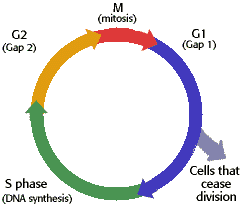Biology Dept Kenyon College |
Cell Cycle in Eukaryotes |

|
Biology Dept Kenyon College |
Cell Cycle in Eukaryotes |

|
| Cell cycle in
Eukaryotes
Cancer The cell cycle consists of an ordered set of events, resulting in the production of two daughter cells. The stages of the cell cycle are shown here:  Not all cells proceed through the stages of the cell cycle at the same rate. Embryonic cells divide very rapidly, while mature cells might divide rarely, or in response to signals such as wounding, or not at all. This regulation required a number of control mechanisms. Transitions out of gap phases (G1, G2) are regulated by cyclins and cyclin dependent kinases (CDK). Cyclins are only present at certain times during the cell cycle. MPF (Maturation Promoting Factor) includes the CDK and cyclins that triggers progression through the cell cycle.
Growth factors can also stimulate cell division. Growth factors serve as signals that tell the cell to move through the cell cycle and in order to divide. What about blocking the cell cycle? Severe defects in chromosomes block progression through the cell cycle, and can lead to cell suicide, or apoptosis. In addition, cells have a finite lifespan, and at some point are no longer able to divide. Cancers are diseases in which there is a defect in the regulation of the cell cycle. Cancer cells are rapidly dividing cells that no longer are controlled by the mechanisms listed above. Cancer cells can form tumors due to this unchecked growth. Cancers are caused by genetic mutations. Sometimes these mutations are found in the germline, and result in inherited cancers or a predisposition to cancer. Most often these mutations are found in somatic cells. Somatic mutations accumulate over our lifetime. Cancers are caused by multiple genetic mutations. Except in rare cases, cancer cells have accumulated a number of mutations. Look at figure 18.18 from Purves et al. to follow the accumulation of multiple mutations in colon cancer. Three classes of genes are involved in cancer: oncogenes, tumor suppressor genes, and DNA repair genes. Proto-oncogenes (unmutated oncogenes) stimulate cell division in a regulated manner. Proto-oncogenes include growth factors, growth factor receptors, and cyclins. Oncogenes are mutated forms of these genes that result in unregulated stimulation of cell division. Tumor suppressor genes prevent cell division. Mutations in tumor suppressor genes result in the loss of this prevention of cell division. DNA repair genes promote repair of mutations that occur during the cell cycle. Loss of DNA repair genes results in the accumulation of many mutations within a cell. This chart shows the effect of proto-oncogenes, oncogenes, and tumor suppressor genes on cell division.
This diagram shows the location of cancer
genes in the
human genome. Find them in OMIM.
Online practice problems: Try problems 1-4 and 9 of the Cell Cycle & Mitosis Problem Set from the Biology Project at the Univerisity of Arizona. You can learn a lot more about cell cycle regulation, cancer, and apoptosis from these websites: |